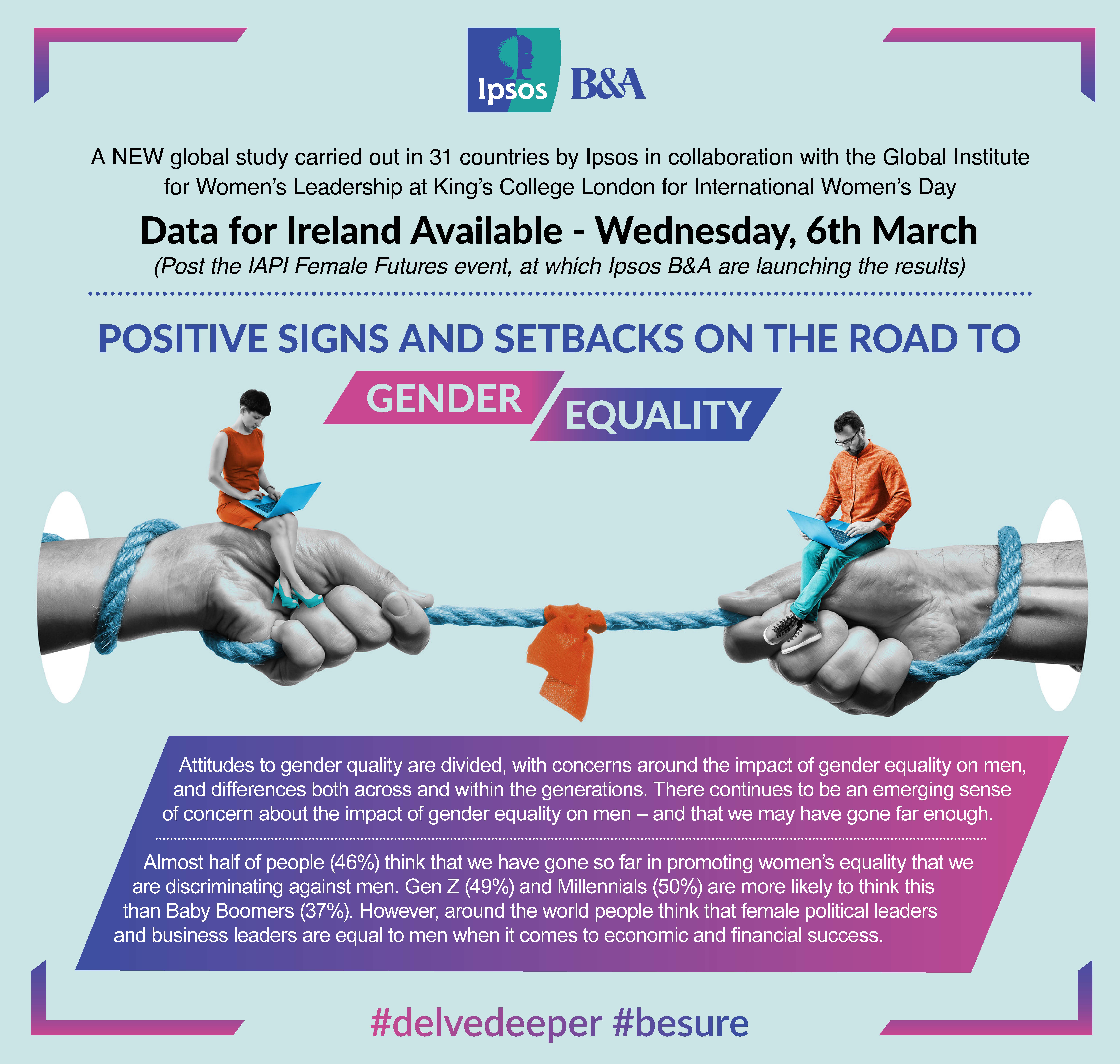POSITIVE SIGNS AND SETBACKS ON THE ROAD TO GENDER EQUALITY

A NEW global study carried out in 31 countries by Ipsos in collaboration with the Global Institute for Women’s Leadership at King’s College London for International Women’s Day shows that:
- General attitudes to gender equality remain divided, particularly across the generations with young people and older people having differing views about what gender equality means.
- There continues to be an emerging sense of concern about the impact of gender equality on men – and that we may have gone far enough. Almost half of people (46%) think that we have gone so far in promoting women’s equality that we are discriminating against men. Gen Z (49%) and Millennials (50%) are more likely to think this than Baby Boomers (37%).
- There are some positive signs about gender equality with people seemingly not concerned about the gender of political or business leaders. If given the choice, more than half of people have no preference about the gender of their political leader or boss (57% and 58% respectively).
ATTITUDES TO GENDER QUALITY ARE DIVIDED– WITH CONCERNS AROUND THE IMPACT OF GENDER EQUALITY ON MEN – AND DIFFERENCES BOTH ACROSS AND WITHIN THE GENERATIONS
People recognise that male allyship is important. 65% of people agree that women won’t achieve equality in their country unless men taken actions to support women’s rights too.
But there are setbacks.
- Around half of people across a 31- country average think that men are being asked to do too much to support gender equality (52%).
- Almost half of people (46%) think that we have gone so far in promoting women’s equality that we are discriminating against men.
Whilst there hasn’t been much change since last year, the long-term trends show some attitudinal shifts across the comparable countries that have been included in the survey over the past five years.
- Across 24 countries, the proportion of people that think men are being asked to do too much to support gender equality has risen from 41% in 2019 to 52% in 2024.
- The proportion of people that think when it comes to giving women equal rights with men things have gone far enough in has risen from 41% to in 2019 to 54% in 2024 across the 24 comparable countries.
Views on gender equality differ across generations, the youngest are not always the most progressive.
- Gen Z and Millennials are more likely to think agree that a man who stays home to look after his children is less of a man (25%, 27% respectively) than Gen X (20%) and Baby Boomers (11%).
- Over half of Gen Z and Millennials think when it comes to giving women equal rights with men, thing have gone far enough in my country (57% Gen Z, 59%, Millennials) compared with two in five Baby boomers (43%).
- There is a 20-percentage point difference between Gen Z men and women when it comes to thinking women’s equality discriminates against men. Six in ten (60%) Gen Z men say this is the case, while four in ten (40%) feel this way.
AROUND THE WORLD PEOPLE THINK THAT FEMALE POLITICAL LEADERS AND BUSINESS LEADERS ARE EQUAL TO MEN WHEN IT COMES TO ECONOMIC AND FINANCIAL SUCCESS
Gender appears to make little difference in people’s opinions about a leader’s capability to deliver economic and financial success.
The majority of people across a 31- country average think male and female politicians are equally good at defending national security (43%), getting the economy back on track (43%) and fighting crime (42%). Or, that they are both equally as bad as each other (17%, 22% and 21% respectively).
Of those that have a preference, people are just as likely to think that male or female politicians are better getting the economy on track (10% male politicians are better versus 11% female politicians are better).
Just over half of people across a 31- country average, think that male and female business leaders are both equally good at creating a financially successful and innovative company (both 55% respectively). Again, of those with a preference there is a marginal difference between those that think male or female business leaders are better are creating a financially success company (both 13% male or female leaders are better), or innovative company (11% male leaders are better versus 13% female leaders are better).
EXPERIENCE COUNTS – PEOPLE WITH EXPERIENCE OF BOTH MALE AND FEMALE POLITICAL LEADERS AND BUSINESS LEADERS ARE MOST LIKELY TO SAY THEY HAVE NO PREFERENCE ABOUT THE GENDER OF THEIR LEADER
Overall people tend not to have a preference about the gender of their political or business leaders – the majority of people say they would have no preference towards a man or a woman if given a choice (57% and 58% respectively).
But experience matters. The more people have experience of male and female leadership, the less likely they are to care about their leaders’ gender.
- Seven in ten people (70%) who have experience living under a male or female politician have no preference when it comes to choosing the gender of their political leader.
- Two-thirds (66%) of people who have experience working under a male and female boss have no preference when it comes to choose the gender of their boss at work.
Similarly, those who only have experience working with a male boss are more likely to choose a male boss (46%) and those who only have experience working with a female boss are likely to choose a female boss (59%).
And people are more likely to prefer bosses of their own gender with 22% of women preferring a boss who was a woman (vs 12% of men) and 26% of men saying they would prefer a boss who was a man (vs 17% of women).
Ipsos B&A will be sharing the Irish results from this survey at the IAPI Female Futures Fund event on Wed, 6th which Ipsos B&A are delighted to be sponsoring.
TECHNICAL DETAILS
These are the results of a 31-country survey conducted by Ipsos on its Global Advisor online platform and, in India, on its IndiaBus platform, between Friday, December 22, 2023 and Friday, January 5, 2024. For this survey, Ipsos interviewed a total of 24,269 adults aged 18 years and older in India, 18-74 in Canada, Republic of Ireland, Malaysia, New Zealand, South Africa, Turkey, and the United States, 20-74 in Thailand, 21-74 in Indonesia and Singapore, and 16-74 in all other countries.
The sample consists of approximately 2,000 individuals in Japan, 1,000 individuals each in Australia, Brazil, Canada, China, France, Germany, Great Britain, Italy, New Zealand, Spain, and the U.S., and 500 individuals each in Argentina, Belgium, Chile, Colombia, Hungary, Indonesia, Ireland, Malaysia, Mexico, the Netherlands, Peru, Poland, Singapore, South Africa, South Korea, Sweden, Thailand, and Turkey. The sample in India consists of approximately 2,200 individuals, of whom approximately 1,800 were interviewed face-to-face and 400 were interviewed online.
Samples in Argentina, Australia, Belgium, Canada, France, Germany, Great Britain, Hungary, Italy, Japan, the Netherlands, New Zealand, Poland, South Korea, Spain, Sweden, and the U.S. can be considered representative of their general adult populations under the age of 75. Samples in Brazil, Chile, China, Colombia, Indonesia, Ireland, Malaysia, Mexico, Peru, Singapore, South Africa, Thailand, and Turkey are more urban, more educated, and/or more affluent than the general population. The survey results for these countries should be viewed as reflecting the views of the more “connected” segment of their population.
India’s sample represents a large subset of its urban population — social economic classes A, B and C in metros and tier 1-3 town classes across all four zones.
The data is weighted so that the composition of each country’s sample best reflects the demographic profile of the adult population according to the most recent census data. “The Global Country Average” reflects the average result for all the countries and markets in which the survey was conducted. It has not been adjusted to the population size of each country or market and is not intended to suggest a total result.
When percentages do not sum up to 100 or the ‘difference’ appears to be +/-1 percentage point more/less than the actual result, this may be due to rounding, multiple responses, or the exclusion of “don’t know” or not stated responses.
The precision of Ipsos online polls is calculated using a credibility interval with a poll where N=1,000 being accurate to +/- 3.5 percentage points and of where N=500 being accurate to +/- 5.0 percentage points. For more information on Ipsos’ use of credibility intervals, please visit the Ipsos website.
The publication of these findings abides by local rules and regulations.
CONTACT:
Clare Kavanagh, Director, Ipsos B&A.
Tel: 01 205 7500


